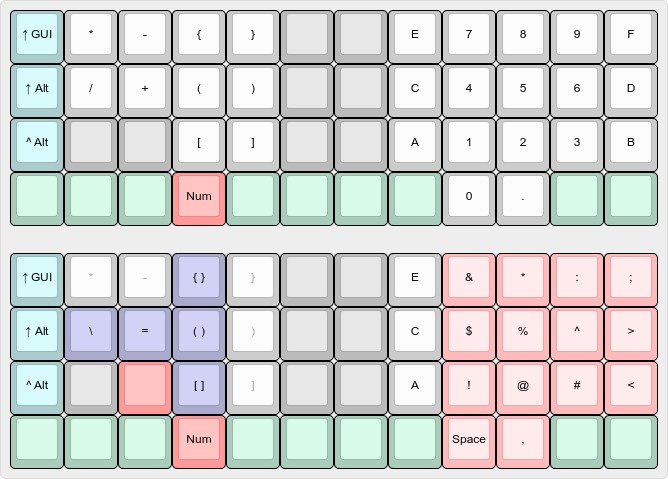wide planck form
just when you think you’re done, there is always another idea to try out! The Colemak forum has long advocated a wide or extended key layout to further enhance the ergonomics of the Colemak layout by remapping the keys such that the left and right hand positions are shifted out by one column. Using a 60% keyboard and radically left shifting the whole layout one column to achieve left and right hand fingering symmetry did not permit increasing the left and right hand separation.
All my previous Planck posts reflected variations on my particular Colemak Shift-DH mod. A recent poster soliciting reviews of his proposed wide QWERTY layout inspired revisiting the idea. The 40% Planck in a conventional layout provides for a single pinkie and index finger extension—very symmetrical and ergonomic.

By remapping the outer key assignments and shifting the logical halves of the layout one column towards the edges of the keyboard, eliminating any pinkie finger extension, each index finger inherits a double column reach in the middle of the keyboard—more than even the wide Colemak mod above—which, I have always been reluctant to do.
However, reducing the range of the generally weaker pinkie finger at the expense of increasing the stretch for the stronger index finger does garner a significant benefit. Namely, increasing hand separation and, thus, the geometry of one’s arms and shoulders and, more importantly, wrist angle. This is very tangibly noticeable and superior.
wide colemak
the inserted double middle column has been assigned lesser used symbols and punctuation. Row assignments and even the set of characters may change (not unsurprisingly, given my history) during usage..

The cursor cluster is altered by the shift of the thumb symbol layer key. The arrangement is unorthodox but works sufficiently for me. Time will tell. The arrangement makes the Left / Right cursor pairing available to the number layer.
The prior pinkie Tab and Delete keys have now been displaced to the central column which are, surprisingly, much easier to reach and use with the thumbs. There is no overloading that digit. Note the double tap Double Quote key. It’s the little details of the Planck!
number layer
left shifting the numerc keypad to align it with the natural split of the layout does cause a bit of a mashup of the hexadecimal characters with the numeric fingering that I impose. Not a big issue for the frequency of hexadecimal input I require..

A second numeric layer is available for the right hand with the associated number symbols and a few others for convenience of input. Using a layer rather than double tapping prevents inadvertent key conversion during rapid data entry.
symbol layer
the symbol layer deviates the most from my previous design with the addition of a secondary layer (and regex symbols) versus over usage of double tap key assignments—again, to prevent inadvertent key conversion during rapid typing, which isn’t typical while composing complex regular expressions but nevertheless..

Removed are the dedicated combination modifiers for the left hand to facilitate the shift. They are not required for my particular desktop environment on this layer, so no inconvenience.
navigation layer
the navigation layer is just shifted relative to the thumb keys that raise the layer..

plover layer
the Plover layer only gains a one column shift..

transition
thus far, the transition has been surprisingly easy. Some finger memory needs be developed for the index finger extensions, but the superior hand position, is probably worthwhile in the long run. The pinkies certainly are well rested!
The only perceptible annoyance that needs to be addressed is the occasional unexpected keyboard action that results from the now increased usage of the outer columns—essentially the A and O keys—which are also defined as compound modifiers. These modifiers are very useful for issuing window manager navigation key chords—being one to eschew using mice.
Some tuning of the Planck firmware is in order or perhaps extending the navigation layer to provide window manager control! Or simply removing the modifier assignment for those two frequently used keys..
